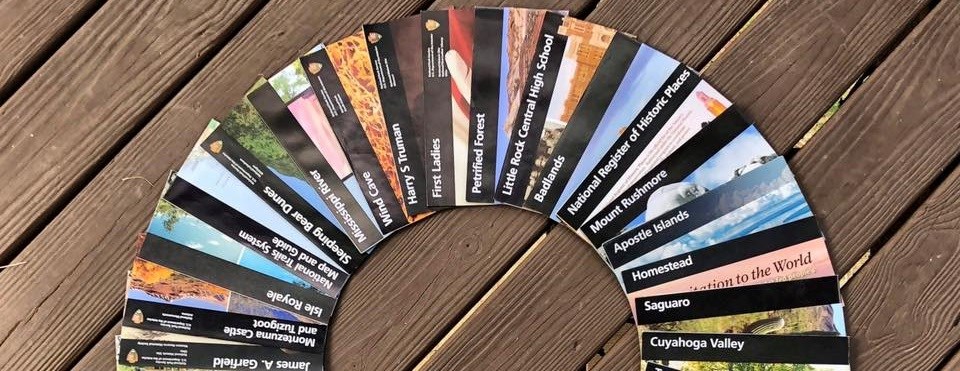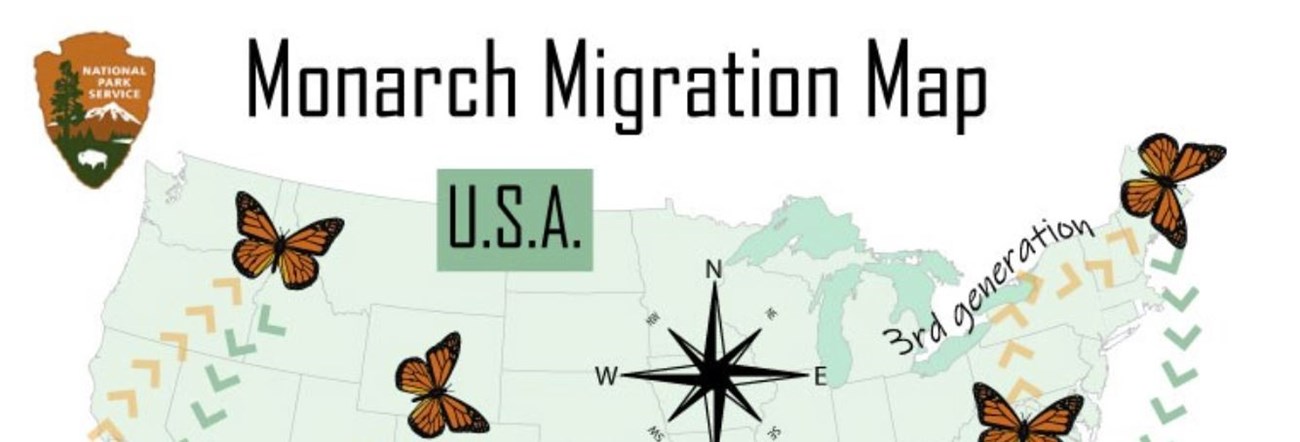Last updated: January 17, 2023
Article
20 Ways to Map Your Journey
Mapping your journey can go in many different directions. Whether heading to a national park or staying in your neighborhood, find suggestions to map trips, history, nature, or your own story.

NPS / Matt Turner
1. Grab a Map
If you are visiting in person, most parks have maps on their official park brochures and websites. Some parks also have ADA-accessible maps for visitors with vision impairments. Find even more map options to explore parks across the country.
2. App Your Journey
Download the free NPS App for interactive maps to use while visiting national parks. Many parks include places of interest, self-guided tours, and suggested trip itineraries included on their maps.
3. Share #YourParkStory
Each person has their own special connections with places in national parks or in communities where National Park Service programs and partners help preserve places of nature, culture, and recreation. Follow National Park Service staff’s park stories on social media using #YourParkStory and share your own using #MyParkStory.
4. Set a Personal Goal
Make a personal checklist of national parks that you will visit this year and track your progress. Choose a history or nature topic, recreation or fitness goals, every park in your state, or a set number, then set off on your adventure.

NPS Photo
5. Collect Passport Stamps
The Passport To Your National Parks® program is offered by our official partner America’s National Parks™ to encourage visiting national parks and preserving memories. How many can you find? (Tip: Use the NPS App to find passport stamps in national parks.)
6. Start a Travel Journal
Compile your pictures, souvenirs, brochures, maps, photos, videos, and stories to chronicle your journeys to national parks. Use them to make a written journal, scrapbook, blog, or series of social media posts.
7. Make a Your Own Map
Are you a mapmaker? The NPMap suite of web map tools enables National Park Service employees and partners to tell the story of the nation's most cherished places using innovative mapping techniques and technologies. Not a mapmaker? Learn more about mapping and cartography to give it a try.
8. Get Started with Some Trip Ideas
Not sure where to start planning a trip to parks? Browse self-guided trip ideas and things to do prepared by rangers to help plan a trip that maximizes your visit tailored to your available time and interests.

Photos courtesy of A. Fawcett (left) and Jen Johnson (right)
9. Share Then with Now
Pull out the old family photos from your childhood or from your parents and grandparents to recreate some memories magic. Revisit places that were family favorites and try to recreate historic photos today.
10. Try Finding Your Way
Finding your way without a phone or GPS is a skill. Learn how to use old-fashioned paper maps to navigate reading the landscape or marked landmarks. Make your own compass and practice using it in your yard or neighborhood before you try a bigger adventure like backpacking in Alaska.
11. Take a Virtual Trip
Not visiting a national park in person? We’ve got you covered with ways to Find Your Virtual Park to stay connected with parks and other places of natural and cultural importance across the country.
City of Rocks National Reserve: Cool Geology Hike in Castle Rocks
Death Valley National Park podcast tour
Denali National Park & Preserve: Science and Research in Denali
Mount Rainier National Park virtual tour
Potomac Heritage National Scenic Trail video tour
Travel Route 66
12. Connect History
Discover our shared heritage with travel itineraries focused on history topics that you can use for in-person or virtual trips. Explore thousands of places significant to American history and culture in national parks and communities on the National Register of Historic Places.

Asahel Curtis, 1928 (Yellowstone National Park postcard collection)
13. Send a Postcard
Sending postcards to family and friends has been a tradition since national parks were created. Mail a postcard or share digital postcards to track your trips. Send a postcard to Arches National Park's Community Artist in the Park and you may get one back!
Antietam National Battlefield antique postcard collection
Appomattox Court House National Historic Site historic postcard collection
First State National Historical Park biodiversity postcard
Fort Smith National Historic Site vintage postcard collection
Hawai'i Volcanoes National Park historic postcard collection
Valley Forge Naitonal Historical Park historic postcard collection
Yellowstone National Park audio postcard collection
Yellowstone National Park historic postcard collection
14. Create Your Own Postcards
Use memories from your trips to national parks to create your own unique postcards of national parks. Be creative with what you use to make 2-dimensional or digital postcards, maybe even creating a game or postcard exchange with family and friends.
Cowpens National Battefield Kids in Colonial Times postcard activity
First State National Historical Park biodiversity postcard activity
Fort Necessity National Battlefield Traveling the National Road postcard activity
Jimmy Carter National Historic Site Plains Peanut Festival Post Card Contest
15. Map Games
Create your own game based on locations, maps, topics of interest, or other features in parks, such as interesting sights and sounds. Games can be played verbally, in writing, on devices, or on social media. Share your game on social media for others to try.
Canyonlands Naitonal Park: The Names of the Canyonlands Scavenger Hunt
Devils Tower National Monument: Map Scavenger Hunt
First State National Historical Park: Plaques, Plaques Everywhere!
Florissant Fossil Beds National Monument: Virtual Night Sky
Hopewell Culture National Historical Park: Travel or Trade?
Timucuan Ecological & Historic Preserve: Online Photo Scavenger Hunt
Where the "Park" Am I? Round 1, Round 2, Round 3
16. Navigate Lesson Plans
Whether learning from home or in a classroom, visit the Educators Portal to find lesson plans and other educational materials using maps or mapping to learn about history and nature.
Four Parks: How Did You Get to Hawai'i?
Cowpens National Battlefield: Mapping the Battle of Cowpens
Cumberland Island National Seashore: Dungeness Map Scavenger Hunt
Dayton Aviation Heritage National Historical Park: Mapping a Neighborhood
Fort Necessity National Battlefield: Traveling the National Road
Fort Scott National Historic Site: A Map Changed by Destiny
George Washington Birthplace National Monument: Chesapeake Bay Living Map
Glacier National Park: Boundaries and People
Glacier National Park: You Are Here
Haleakala National Park: Map Analysis
Natchez Trace Parkway and National Scenic Trail: Planning the Trek Math Lesson
Prince William Forest Park: Introduction to Basic Orienteering
Tuzigoot National Monument: History Detective Scavenger Hunt

NPS Image
17. Follow Nature
Explore nature in national parks, such as like learning about hundreds of migratory species that make annual journeys across land, water, and sky.
18. Map It for Science
Become a citizen scientist to help with professional research collecting data in a park or in your own yard. You can contribute geographic information to many projects, including backyard bird counts and photo-identifying species in locations with an app.
19. Meet Park Mappers
Collecting geographic and spatial information is important for many National Park Service parks and programs. Mapping in national parks is done by National Park Service employees, interns, volunteers, and researchers.
Ellen Frondorf Researching Fire Effects
Emily Roberts and G. William Harrison Invasive Species Management
Rafael "Zak" Wood Creating Data Resources for Park Planning
Research Permit Holders University of Utah Using Seismic Waves to Map the Ground Below Old Faithful
20. Map Research Projects
Mapping is used in many ways by the National Park Service and partners related to safety, planning, and understanding nature and history. Find map resources and thematic map resources.
Mapping the Missile Fields of the Cold War
Mapping Underwater Habitats
NASA Creating New 3-D Maps
Sounding Seafloor Habitats
Space-Based Burn Severity Mapping in Alaska's National Parks
Twelvemile Island Shipwreck Research Project
Uncovering the Civilian Conservation Corps Camps in Rocky Mountain National Park
Vegetation Mapping in the American Southwest
Visualizing the Character of the Blue Ridge Parkway
